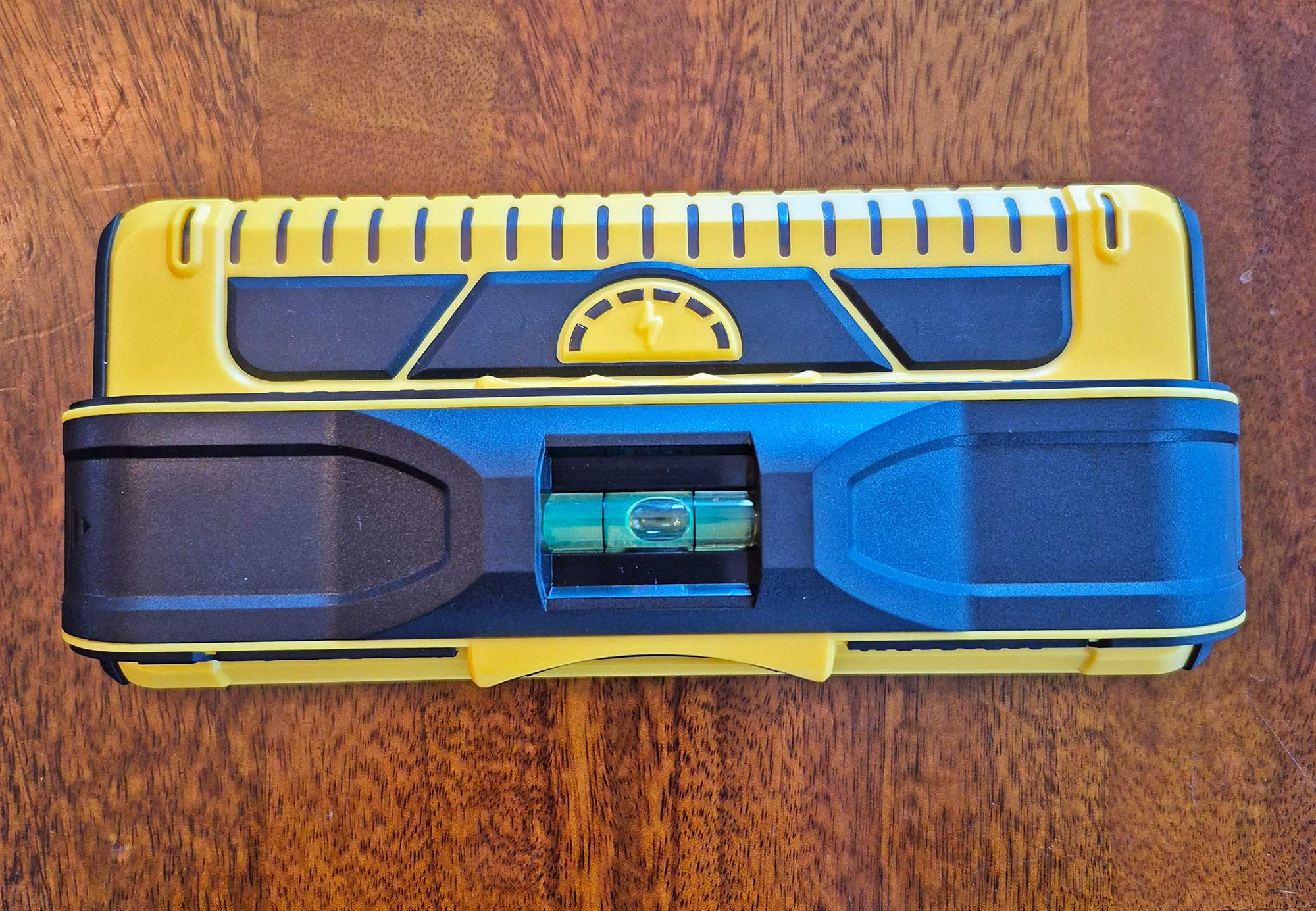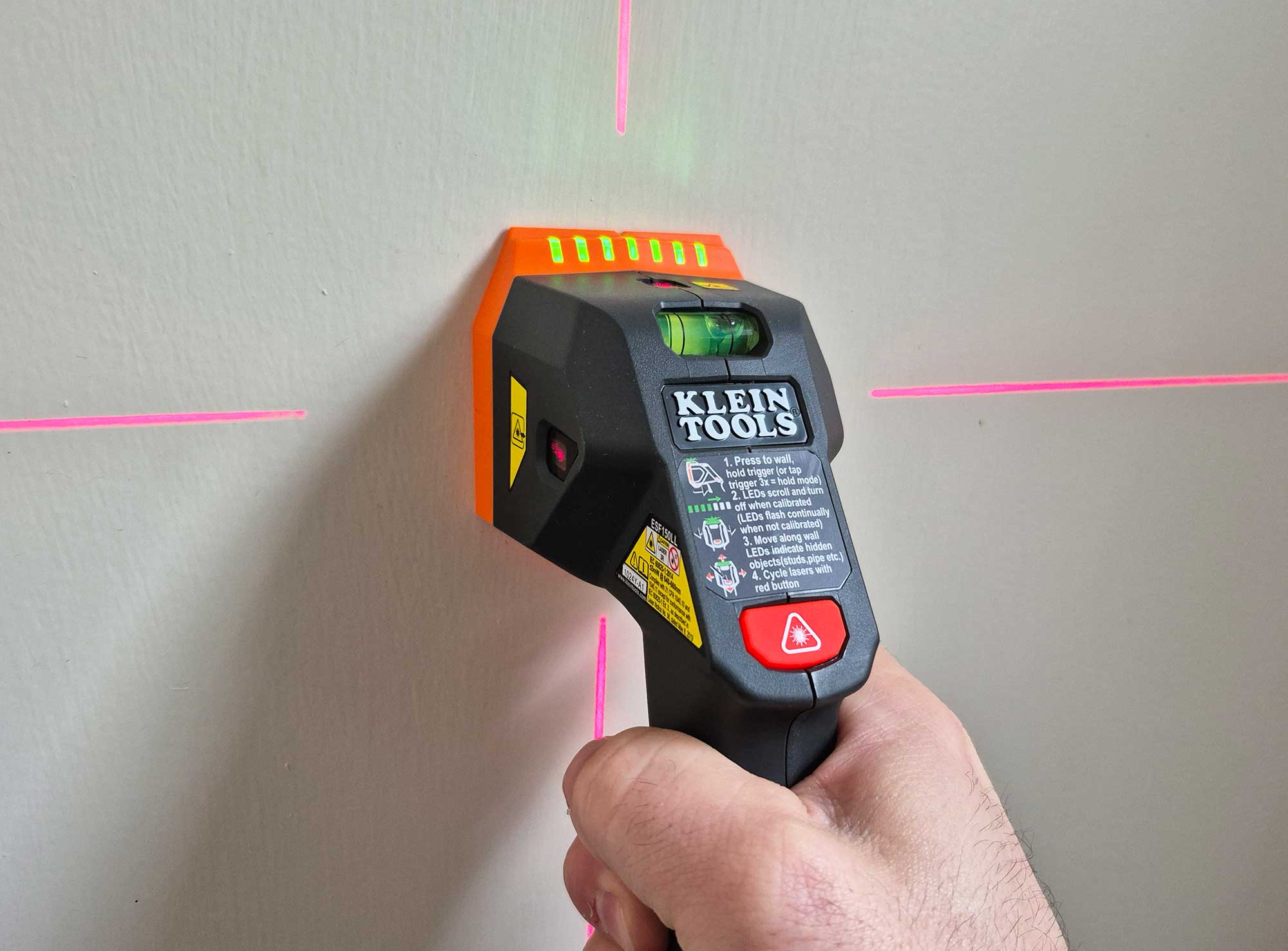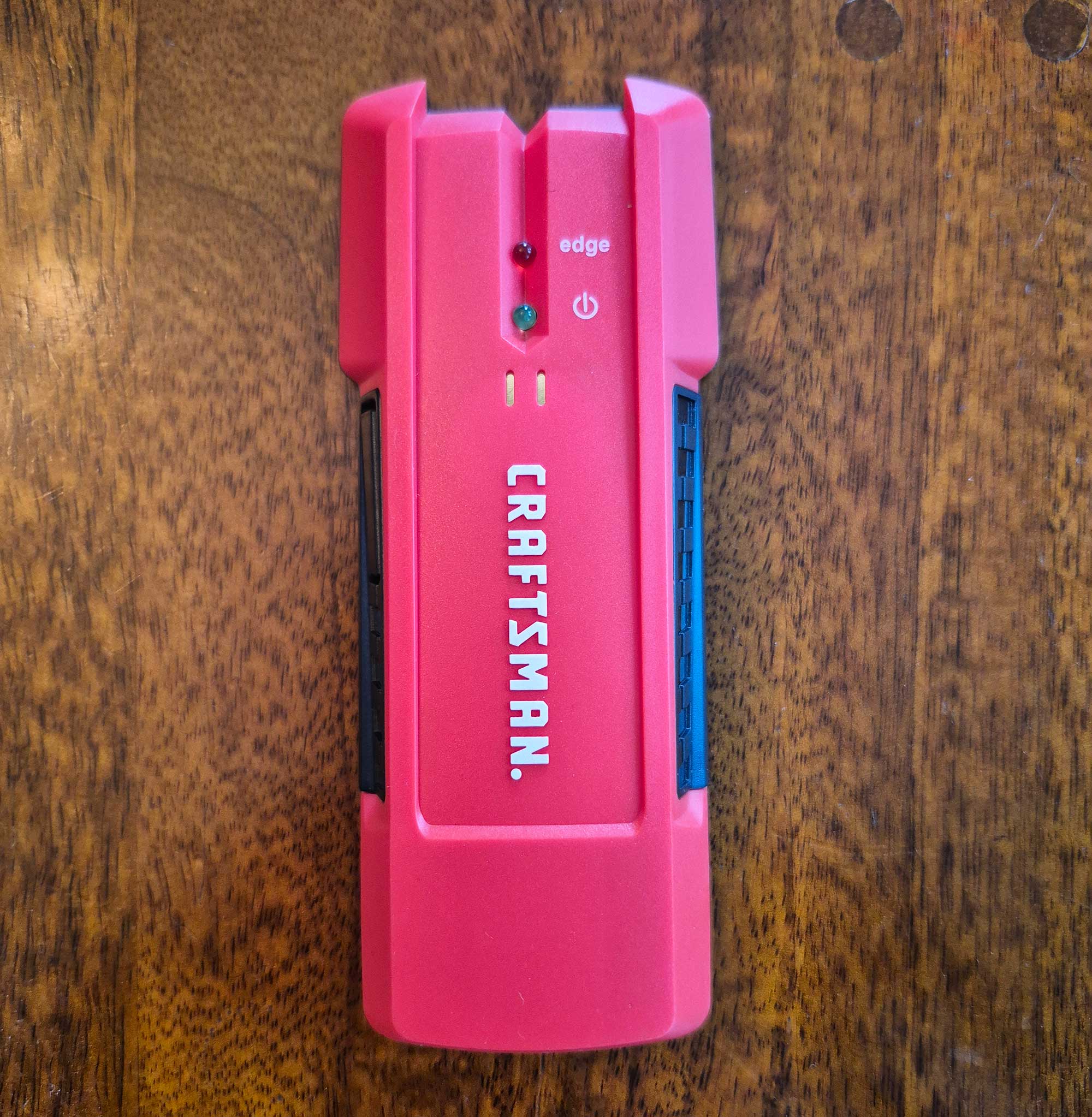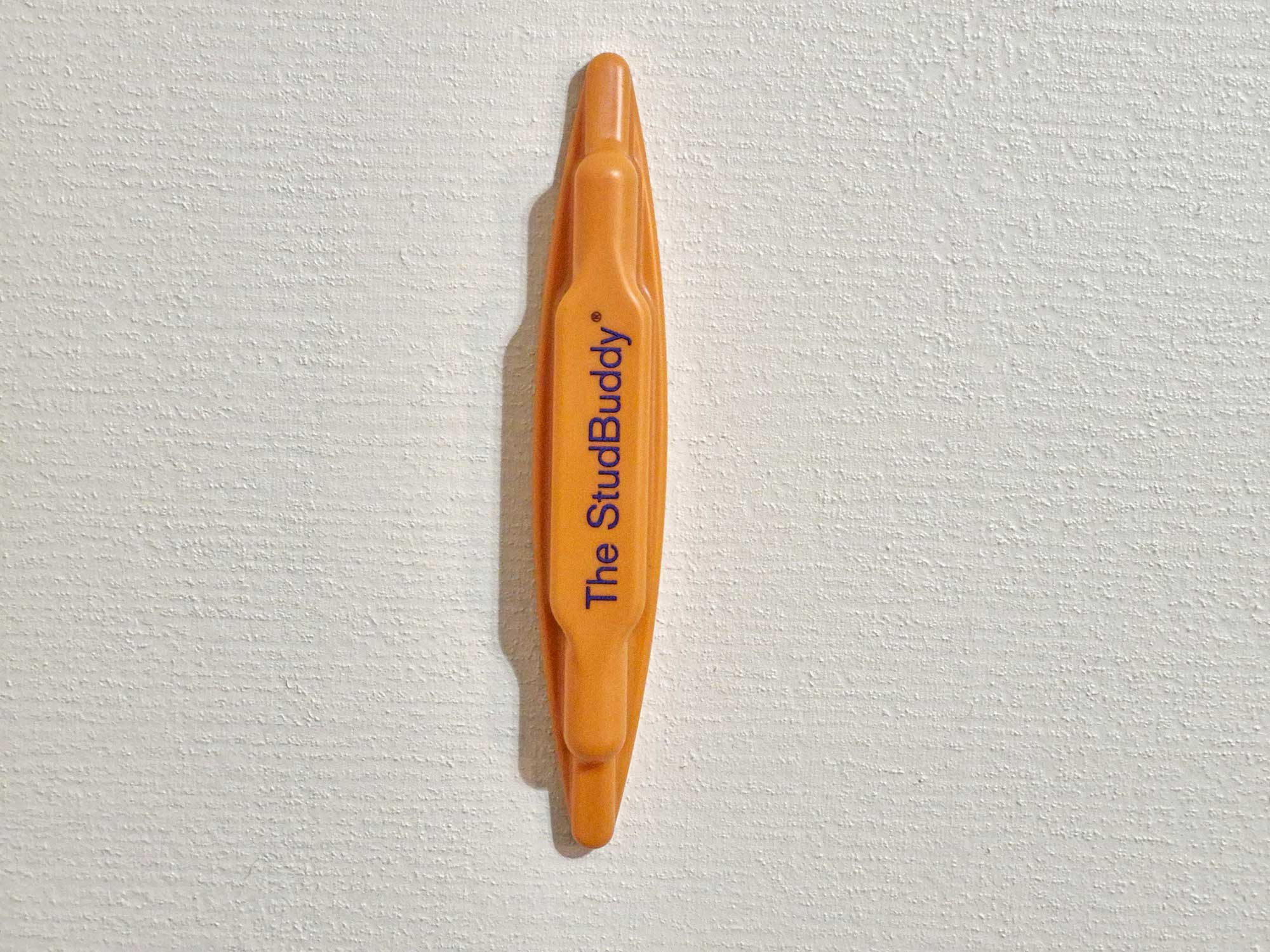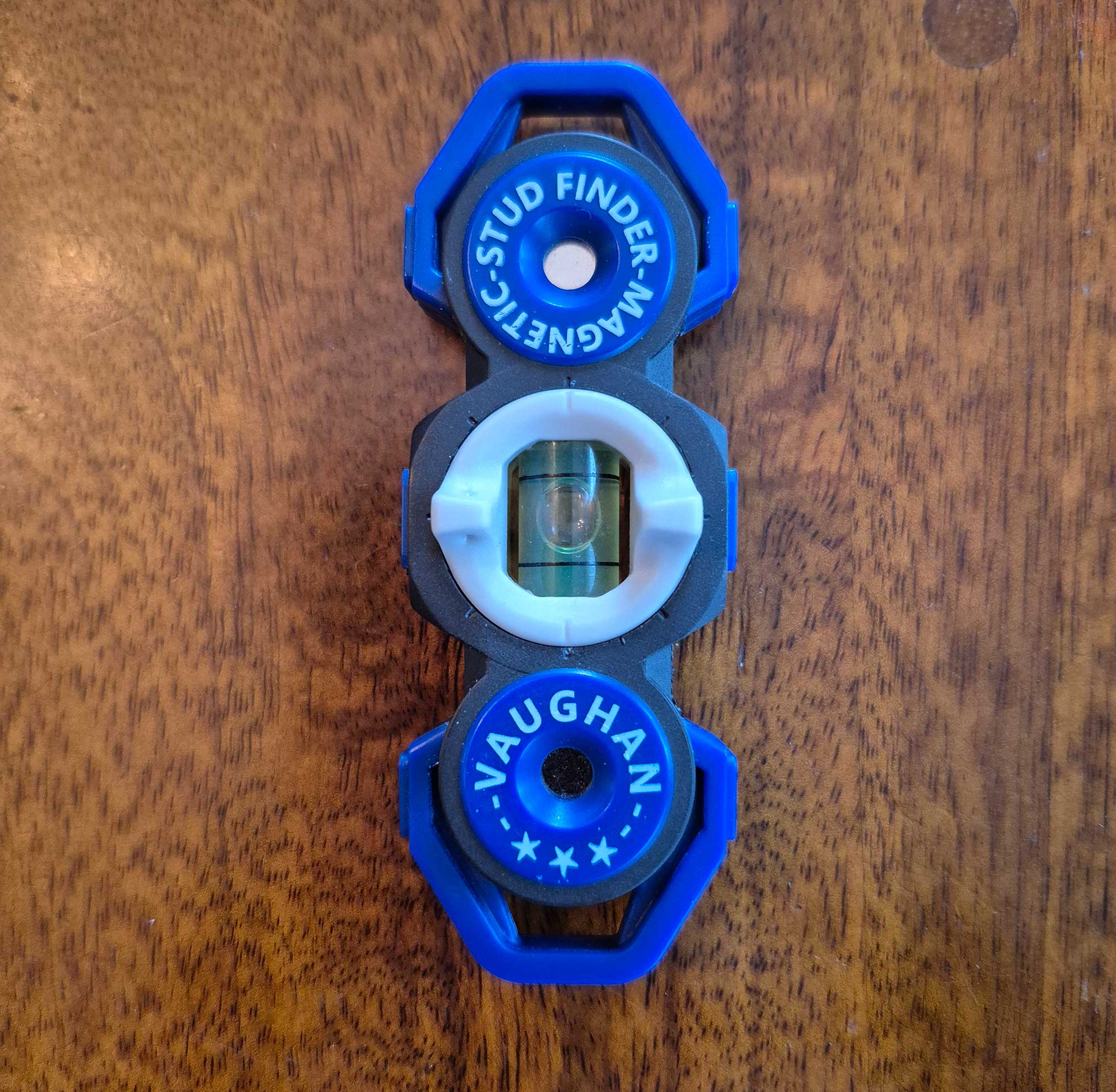The Best Stud Finders of 2025, Tested and Reviewed
We may earn revenue from the products available on this page and participate in affiliate programs. Learn More ›
I recently had a project where I needed to install exhaust fans in two bathrooms which required new wiring, mounting the fan in the ceiling, putting in a wall switch, and venting the fans out of an exterior wall. I needed a stud finder for every one of those steps.
Having a reliable and accurate stud finder is also useful for simpler projects like mounting TV’s on the wall, installing shelving, hanging heavy art or pictures, mounting ceiling fans, and on and on.
Stud finders have been around for a long time, but modern units can do more than just find a stud. Some models detect magnetic and non-magnetic metals, wood and metal studs, and live wires. So now you can not only find your stud, but also get an idea of what else is running through your walls.
- Best Overall: Franklin Sensors ProSensor M210
- Best Features: Bosch GMS120-27
- Best Magnetic Stud Finder: C.H. Hanson Magnetic Stud Finder
- Best Value: Zircon StudSensor A100
- Most Ergonomic: Klein Tools ESF150LL
- Best Budget Stud Finder: Craftsman CMHT77633
- Ryobi ESF5002
- Stanley 77-050
- The StudBuddy Magnetic Stud Finder
- Vaughan Magnetic Stud Finder
How I Tested the Best Stud Finders

To help you choose the best stud finder for you, I put ten of them to the test to see where they worked well, and where they fell short. I organized these tools into two basic categories: magnetic and electric. Magnetic stud finders are simply strong magnets in a housing that cling to the nails or screws beneath the paint and spackle on walls or ceilings. They’re great on drywall or painted OSB in a garage or shop, but they’re not effective on old construction that uses lath and plaster.
Electric stud finders send signals into your wall and interpret those signals when they bounce back. Some will find the edge of a stud, some will find both edges and indicate the center for you, and some will indicate pipes and electrical lines.
I tested the stud finders on a variety of mediums including new construction drywall, thicker ceiling drywall, paneling over drywall, OSB, MDF, and lath and plaster walls. The review for each stud finder will let you know where it excelled, and where it didn’t.
Best Stud Finders: Reviews & Recommendations
Best Overall: Franklin Sensors ProSensor M210
Pros
- Accurate readings on studs and wires
- Widest sensor area
- 13 sensors for high accuracy
Cons
- Heaviest stud finder tested at 11.5 oz
Key Features
-
Shows whole stud: edges and center simultaneously -
Live wire detection -
Auto adjusts for material thickness up to 1.7 inches -
Bubble level -
Pencil included “on board” for marking -
Price: $60
The ProSensor M210 was easy to use, gave almost no false readings, and it had the widest sensing area so you can “see” the stud coming.
This unit is held horizontally, unlike all the other sensors I reviewed, and it gave me the best view of what was behind the wall. As you move it horizontally across the wall, the stud would appear on the side and then move to the middle. In cases close to a door or window where there can be studs close together, I had more than one stud showing at once and I could mark them both. The M210 also showed live wires and the LED indicator would go from one to six lights as you got closer to the wire (6 lights indicate the center of the tool was right on top of it).
The M210 was very easy to use and did well on all mediums that I tested it on. Lath and plaster is the hardest medium to detect studs through, and while the M210 did struggle at times, it gave the most reliable readings out of the bunch.
The ProSensor M210 doesn’t have the most features, but I chose it as the best overall because it is simple to read and use. It’s the least picky about surfaces, and the multitude of sensors gave me the most consistent readings.
Best Featured Stud Finder: Bosch GMS120-27
Pros
- Beep can be turned off
- Easy to use and hold for long periods
- Power button does not need to be constantly held like many other sensors
- Highly sensitive
Cons
- Poor performance on lath and plaster and 1-inch MDF board
Key Features
-
Screen indicates what is being detected, and the center of it -
Live wire detection, metal pipe detection -
AA batteries, or optional Li-ion battery pack -
Color coded marking hole -
Audible beep and lights for detection -
Price: $99
The Bosch GMS120-27 was in strong contention for the best overall award because the feature set is awesome. It reads wood and metal studs, non-magnetic metal, magnetic metal, and wires. Plus, it gives audio and visual indication of everything.
The Bosch GMS120-27 also has a hole for marking the center. I found that it worked well for finding studs, pipes, and wires, even when they were next to each other. The center marking hole lights up green when you’re centered, which is really convenient. The screen displays symbols for what is behind the sensor, whether it be a stud, magnetic metal like a screw or nail, or non-magnetic metal such as a copper pipe, or a live wire. I found that I got good readings with the Bosch, but it did take some interpretation on my part when there were multiple objects close together.
Bosch didn’t take best overall was because it struggled with lath and plaster and it wouldn’t read through 1-inch MDF board (others units in the test did). Other than that, the Bosch GMS120-27 is a great tool that’s packed with capability, and it comes with a pouch to clip on your belt or pocket for easy access.
Best Magnetic Stud Finder: C.H. Hanson Magnetic Stud Finder
Pros
- Bubble level rotates for vertical or horizontal orientation
- Strongest magnets
- Easy to slide across wall
- Reliable way to find nails
Cons
- More expensive than some electric stud finders
Key Features
-
2 magnets -
Bubble level -
Center mark -
Loop for hanging plumb bob -
Price: $15
The effectiveness of a magnetic stud finder really boils down to the strength of its magnets. In my testing the C.H. Hanson snapped to the screws and nails the fastest and seemed to have the strongest magnets of the three magnetic stud finders I tested.
You definitely know it when it runs over a nail or screw, which gives you confidence. As you make your passes back and forth across the wall, slowly moving up or down, you will eventually feel the magnet pull when you cross over a fastener. At that point, you just leave it on the wall, make your mark, and move onto the next stud. If you want to mark the whole thing, you can hang a light plumb bob off the bottom and mark the entire stud (assuming that stud is plumb).
Magnets lose their “power” quickly as you move away from the ferrous material, and so for lath and plaster magnets may not be reliable. However, magnetic stud finders are a simple and reliable way to find fasteners in studs, and the C.H. Hanson Magnetic Stud Finder had the best magnets (by a narrow margin) and that made it my pick for best magnetic stud finder.
Best Value: Zircon StudSensor A100
Pros
- Lightweight
- Accurate reading for studs
- SpotLite Pointer for easy marking
- Simple and easy to read screen
Cons
- Beeping can’t be turned off
- Wire detection only gets you close, not pinpoint
Key Features
-
Edge and center detection -
Live wire detection -
Deep Scan for up to 1.5 inches or Stud Scan for up to .75 inches -
Visual and audible detection -
Price: $33
The Zircon A100 finds the edge and center of a stud, has a stud or deep scan mode, and will detect wires, all for about $33. The Zircon A100 is simple to use and read, and gave me good readings for studs. The icon consistently lit when the sensor was near live wires. The “SpotLite” feature projects an arrow on the wall so you know exactly where to mark. The edges and center of studs are clearly indicated with a beep and lights.
The only downside is that the beep does not stop until you move off the stud, or let go of the power button. If you are marking the sides and the center, the beep can get a little annoying, but that is more of a nit-pick than anything. The Zircon A100 worked well, and was the only tool that offered wire detection at this price range, which is a nice feature for renovation and moving walls. Overall, the Zircon A100 best stud finder for the money.
Most Ergonomic Stud Finder: Klein Tools ESF150LL
Pros
- Level and lasers make marking fast and easy
- Comfortable grip and trigger set-up
- Bright LED’s indicate edges and center of studs
Cons
- No wire detection
Key Features
-
Shows whole stud, edges and center simultaneously -
Lasers can project vertically and horizontally for marking -
Bubble level -
Trigger can be momentary hold or set for continuous scan -
Scans up to 1.5 inches deep -
Price: $60
The Klein ESF150LL has a unique design that has a pistol grip and trigger at an angle to the wall for comfortable use. The Klein Tools ESF150LL is the most comfortable stud finder to use. It has a pistol style grip with a trigger that can be held down for detecting, or, with 3 quick presses, it will stay in constant scanning mode. This is a great feature if you have to mark a bunch of studs.
The bubble level is easy to see and keeps the lasers plumb and level for marking. The button used to cycle through the lasers is easy to reach with your thumb while you’re holding down the trigger. You can have vertical only, horizontal only, or vertical and horizontal together. The lasers are bright and easy to see, and are convenient for laying out shelving or hanging things, and if you need to mark a whole stud from ceiling to floor, the Klein is the one to grab. The Klein gave more odd readings on lath and plaster than others in my test, but with a little patience, finding studs was still doable. The only real downside is the lack of wire detection.
If you need one of the best laser levels to complete your project, read my full buying guide.
Best Budget Stud Finder: Craftsman CMHT77633
Pros
- Super lightweight
- Easy on the wallet
- Accurate on most surfaces
Cons
- 9v Battery costs almost as much as the tool
- Need to detect from both sides to find edges, then measure for center
Key Features
-
Indicates edge of stud -
Beep and Light to indicate -
Lifetime warranty -
Price: $12
The Craftsman is the least expensive stud finder in the test, and if you just need to find the edge of a stud, the Craftsman was plenty reliable. It’s the only tool with a lifetime warranty. The Craftsman CMHT77633 is an old-school electric stud finder. It will light up and beep when you come to the edge of a stud, and then you repeat the process from the other side to find the other edge. It won’t detect wires or pipes, but it’s only $12, and it has a lifetime warranty. For a basic unit, the Craftsman can’t be beaten. It did struggle with lath and plaster, but so did other much more expensive units. It’s rated for .75 inches of depth, but I was consistently detecting metal and wood behind a 1” MDF board. The Craftsman is cheap, basic, and pretty reliable. If that is what you need, the Craftsman is the tool for you.
Ryobi ESF5002
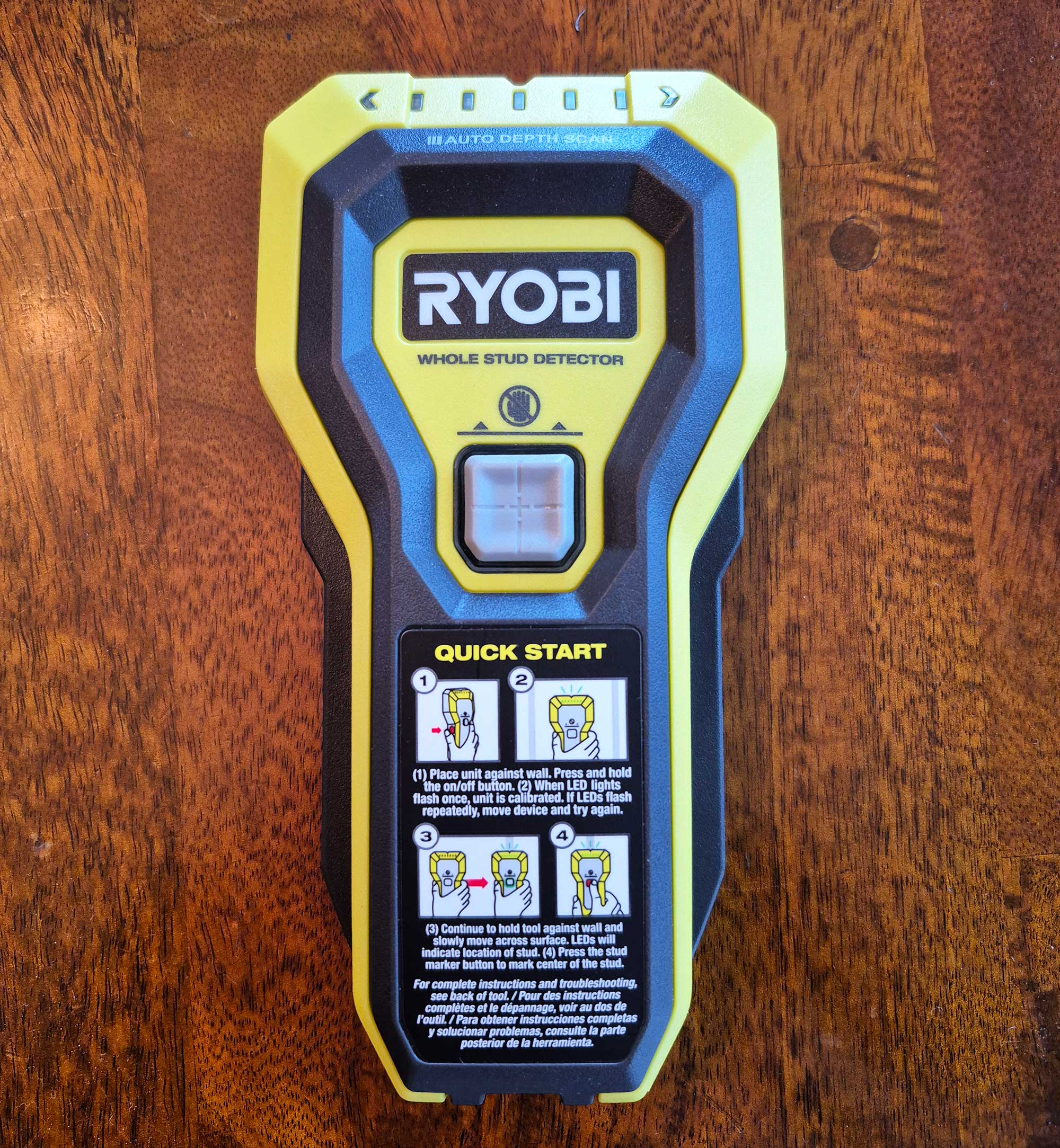
Pros
- Accurate readings on wood and metal studs
- Bright LEDs show edges
- Center mark Button lights green to indicate center
Cons
- No wire detection
- Lots of false readings on lath and plaster
Key Features
-
Shows whole stud- edges and center simultaneously -
Auto Depth Scan for wall material thickness up to 1.5 inches -
Green LED indicator lights -
Built in center mark punch -
Price: $34
The Ryobi ESF5002 worked well on all surfaces except lath and plaster. The wide sensor shows the whole stud and the unique center punch lights up when you’re centered. The center punch is just a button with a sharp point that marks the wall when you push it. There is also a notch by the LED’s so you can mark the center with a pencil if you don’t want to leave a divot in the wall.
The Ryobi is light, but also one of the largest tools in the test. While it was reliable for finding studs, there were other tools that would do the same job for less money. I liked the center punch idea, and the LED’s are nice and bright. The batteries are easy to change and the tool works well. If you are a Ryobi fan, and want to keep with their line, the ESF5002 will get the job done, but I don’t think it has as much value as the other tools in its price range.
Read Next: Best Laser Tape Measures
Stanley 77-050
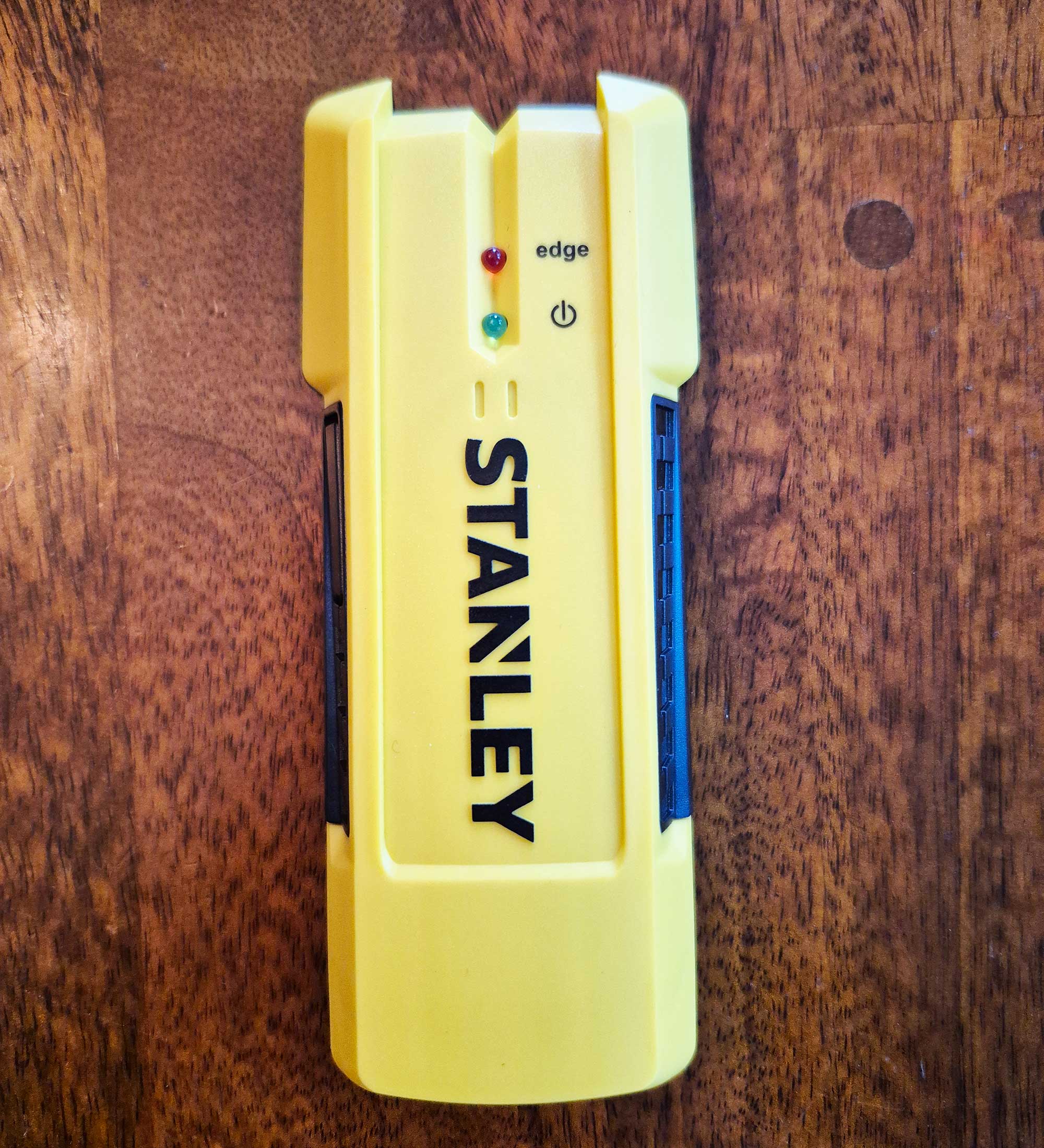
Pros
- Accurate readings on studs
- Lightweight
- Inexpensive
Cons
- Less features than the Craftsman, but costs more
Key Features
-
Indicates edge of stud -
LED to indicate -
Scans up to .75 inches -
Price: $15
The Stanley 77-050 looks identical to the Craftsman on the list, but it lacks an audible beep, and costs a few bucks more. It’s another old-school type stud finder that indicates the edge of a stud with a small LED labeled “edge”. However, unlike the Craftsman, the Stanley has the little sound ports blocked off and offers no beep. Other than that, (and the color) the Craftsman and the Stanley look and function identically. The Stanley is not a bad tool, but the Craftsman is superior. If it’s on sale, or the craftsman isn’t available, and you need an electric stud finder for cheap, then the Stanley 77-050 will do the job.
The StudBuddy Magnetic Stud Finder
Pros
- No batteries required
- Wide magnet spacing makes detection faster
- Two Pack makes locating and marking studs easier
Cons
- Magnets not quite as strong as others tested
Key Features
-
2 magnets in each -
Made in USA -
Price: $18 for 2-pack, $10 for single
The StudBuddy comes in a two pack, and the long narrow design makes lining up a stud easy work. The magnetic stud finders worked well, and it was really nice having two of them. I was able to leave one on the first stud I found, and then narrow my search for the next one by estimating the 16 inches between the studs. I was also able to leave one high on a stud and then search for the bottom of the stud which made marking a whole stud easy. The magnets were not quite as strong as the other two I tested, but the StudBuddy did slide easily across the wall surfaces and I was able to find all of the studs that the other magnet finders were able to. Overall, The Studbuddy was easy to use, and the differences between the magnetic stud finders were very small. The Studbuddy has the best price point, and they did a good job locating the fasteners.
Vaughan Magnetic Stud Finders
Pros
- Easy to use
- Durable
- Level aids in accurate marking
Cons
- Magnets not quite as powerful as the C.H. Hanson
Key Features
-
2 strong magnets -
Bubble level has 4 positions -
Plumb can be hung from either end -
Price: $17
The Vaughan Magnetic Stud Finder did a good job sticking to nails and screws, and it slid easily across the different wall surfaces. It has a very similar build to the C.H. Hanson, and the only reason the Vaughan didn’t take the best spot is because the magnets were slightly weaker. However, it is basically a toss up between the magnet finders in the test (I did like the Vaughan bubble level). The Vaughan did a good job of finding nails and screws, and is a great low-tech way to get the job done.
FAQs
A: There are some small differences, but for electric stud finders, you place the finder against the wall, and then press and hold the power button until it calibrates, usually indicated with a beep or flash. Then you slowly move it across the wall and wait for it to indicate a stud. If there are strange readings, or flashing lights, repeat the process from a different part of the wall as you may have calibrated on a stud or other anomaly. For magnetic stud finders, hold them against the wall and move horizontally in a 2 ft wide zig-zag motion moving up or down the wall until the magnets find a fastener. I usually move about 2 to 3 inches up or down when I’m searching for a stud with magnets.
A: Yes! Electric stud finders can be affected by very high humidity, or a high moisture content in a wall. For example, if you recently put in wallpaper, it will likely need to dry for more than a week before you can be confident in your readings. Many are so sensitive that having your other hand on the wall can affect the readings if it’s too close. Other electromagnetic fields from cell phones and other devices close by can also affect readings. Be sure to read the directions to eliminate these types of factors before deciding that the stud finder doesn’t work properly. Also, some wallpapers have metal foils or threads which can skew readings.
A: Generally speaking, no. But if they are full of water, they can sometimes affect readings on many detectors.
A: Lath and plaster is difficult because it’s inconsistent by nature. Plaster is applied by hand, and so the thickness varies. Stud finders work by reading differences between materials, and having so much variability “confuses” the readings and makes it more difficult to get an accurate picture of where studs are.
Final Thoughts on the Best Stud Finders
Both magnetic and Electric stud finders have a place in the toolbox. The low-tech approach of the magnetic finders will work in many situations, and they are great for simple projects like hanging a TV or a shelf. However, for larger jobs that might include cutting new doorways, or new windows, or moving walls, a stud finder that will detect wires and pipes might save you a whole lot of headache and money. I’ll always have at least one of each in my tool kit because they each serve a purpose.
The post The Best Stud Finders of 2025, Tested and Reviewed appeared first on Outdoor Life.

